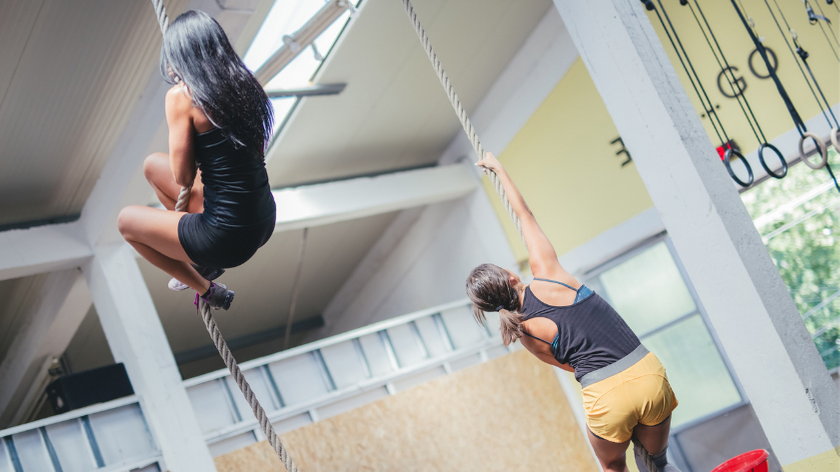The progression of “Gymnastics” skills
13/12/2020 # Home

Our use of the term “gymnastics” not only includes the traditional competitive sport that we have seen on TV but all activities like climbing, yoga, calisthenics, and dance, where the aim is body control.
It is within this realm of activities that we can develop extraordinary strength (especially upper body and trunk), flexibility, coordination, balance, agility, and accuracy. In fact, the traditional gymnast has no peer in terms of development of these skills.
CrossFit recommends using short parallel bars, mats, still rings, pull-up and dip bars, and a climbing rope to implement our gymnastics training.
The starting place for gymnastic competency lies with the well-known callisthenic movements: pull-ups, push-ups, dips, and rope climbs. These movements need to form the core of your upper-body strength work. Set goals for achieving benchmarks like 20, 25, and 30 pull-ups; 50, 75, and 100 push-ups; 20, 30, 40, and 50 dips; 1, 2, 3, 4, and 5 consecutive trips up the rope without any use of the feet or legs.
At 15 pull-ups and dips each, it is time to start working regularly on a “muscle-up.” The muscle-up is moving from a hanging position below the rings to a supported position, arms extended, above the rings. It is a combination movement containing both a pull-up and a dip. Far from a contrivance, the muscle-up is hugely functional. With a muscle-up, you will be able to surmount any object on which you can get a finger hold—if you can touch it, you can get up on it.
The value here for survival, police, firefighter, and military use is impossible to overstate. Pull-ups and dips are the key to developing the muscle-up.
While developing your upper-body strength with the pull-ups, push-ups, dips, and rope climbs, a large measure of balance and accuracy can be developed through mastering the handstand. Start with a headstand against the wall if you need to. Once reasonably comfortable with the inverted position of the headstand, you can practice kicking up to the handstand again against a wall. Later take the handstand to the short parallel bars or parallettes without the benefit of the wall. After you can hold a handstand for several minutes without benefit of the wall or a spotter it is time to develop a pirouette. A pirouette is lifting one arm and turning on the supporting arm 90 degrees to regain the handstand, then repeating this with alternate arms until you have turned 180 degrees.
This skill needs to be practiced until it can be done with little chance of falling from the handstand. Work in intervals of 90 degrees as benchmarks of your growth—90, 180, 270, 360, 450, 540, 630, and finally 720 degrees.
Walking on the hands is another fantastic tool for developing both the handstand and balance and accuracy. A football field or sidewalk is an excellent place to practice and measure your progress. You want to be able to walk 100 yards in the handstand without falling.
Competency in the handstand readies the athlete for handstand presses. There is a family of presses that range from relatively easy ones that any beginning gymnast can perform to ones so difficult that only the best gymnasts competing at national levels can perform. Their hierarchy of difficulty is bent arm/bent body (hip)/bent leg; straight arm/bent body/bent leg; straight arm/bent body/straight leg; and bent arm/straight body/straight leg; and finally the monster: straight arm/ straight body/straight leg. It is not unusual to take 10 years to get these five presses!
The trunk flexion work in gymnastics is beyond anything you will see anywhere else. Even the beginning gymnastics trunk movements cripple bodybuilders, weightlifters, and martial artists. The basic sit-up and “L” hold are the staples.
The L-hold is nothing more than holding your trunk straight while supported by locked arms with hands on a bench, the floor or parallel bars; the hips are kept at 90 degrees with legs straight out in front of you. You want to work towards a three-minute hold in benchmark increments of 30 seconds—30, 60, 90, 120, 150, and 180 seconds. When you can hold an “L” for three minutes, all your old ab work will be silly easy.
We recommend Bob Anderson’s “Stretching.” This is a simple, no nonsense approach to flexibility. The science of stretching is weakly developed, and many athletes, like gymnasts who demonstrate great flexibility, receive no formal instruction. Just do it. Generally, you want to stretch in a warm-up to establish a safe, effective range of motion for the ensuing activity and stretch during cool down to improve flexibility.
Every workout should contain regular gymnastic/callisthenic movements that you have mastered and other elements under development. Much of the rudiments of gymnastics come only with great effort and frustration—that is acceptable. The return is unprecedented and the most frustrating elements are most beneficial—long before you have developed even a modicum of competency.
If you want to learn about the PA Coaching, PA Home program or the PA Strength and Conditioning program or want to subscribe for it then click below:
